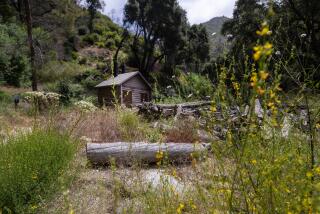New U.S. Rules Limit Target Shooting to 8 Cleveland Forest Areas
Concern for public safety and the preservation of wildlife have led to a new regulation for target shooting in the Cleveland National Forest, U.S. Forest Service officials said.
Target shooting, also known as plinking, will now be allowed only in eight designated areas of the forest--a section of Kitchen Creek Road, three portions of Bear Valley Road, a part of Bear Valley Loop Road, a section of Cameron Road, and two areas along Fred Canyon Road.
All the areas have mountains in the background to act as backstops for speeding bullets and are well distant from residential, camping and recreational areas, said Dan Gustafson, U.S. Forest Service resource protection officer.
The designated shooting areas are marked by signs and yellow posts. Plans for the designated shooting areas were first drawn about a year ago and the new rule went into effect Aug. 12, according to Forest Service officials. Until then, people were allowed to shoot anywhere in the forest.
Target shooting “became more or less unmanageable . . . especially with the increased popularity of handguns,” Gustafson said. “It got to the point where we were shutting off quite a few areas to shooters and it got confusing to pinpoint which areas shooting was allowed in.”
Another change allows bow and arrow hunting in the Laguna Mountain Recreation Area, although it is still closed to guns. Seasonal hunting will continue to be permitted in all other areas of the forest.
Gustafson said the main concern behind the new regulation is the safety of visitors to the 567,000-acre Cleveland National Forest, which sprawls across parts of Orange, Riverside and San Diego counties. The multipurpose national forest concept--allowing hikers, campers, grazing cattle, off-road vehicles, and hunters and target shooters to share the forest--complicates matters, Gustafson said.
The sharing was not working out because shooters often discharged guns too close to horseback trails, scaring horses and endangering the lives of riders, he said. They also shot near campgrounds, trails for off-road vehicles and houses.
“One time, someone shot across a road, which is illegal, and the shot went through a house,” Gustafson said. “No one was hurt but someone could very well have been.”
Other times, cattle have been used as targets. The federal government leases some tracts in the forest for grazing.
Another big factor in establishing designated shooting areas was the damage being done to natural resources by the shooters, Gustafson said.
“People would put up targets on trees,” Gustafson said. Some of the trees killed were more than 200 years old, he added. Some shooters also used government property such as signs, water boxes set up for birds, and fire engines as targets, he said.
Junked television sets, water heaters and even bowling balls served as targets, Gustafson said. “It ends up being a dump after awhile,” he said.
The penalty for illegal shooters can range from a $35 fine to six months in jail and a $10,000 fine.
Maps of the new shooting areas are available at the Alpine Ranger Station, 3348 Alpine Blvd., Alpine, or the Forest Supervisors Office, 880 Front St., San Diego.
More to Read
Sign up for Essential California
The most important California stories and recommendations in your inbox every morning.
You may occasionally receive promotional content from the Los Angeles Times.










